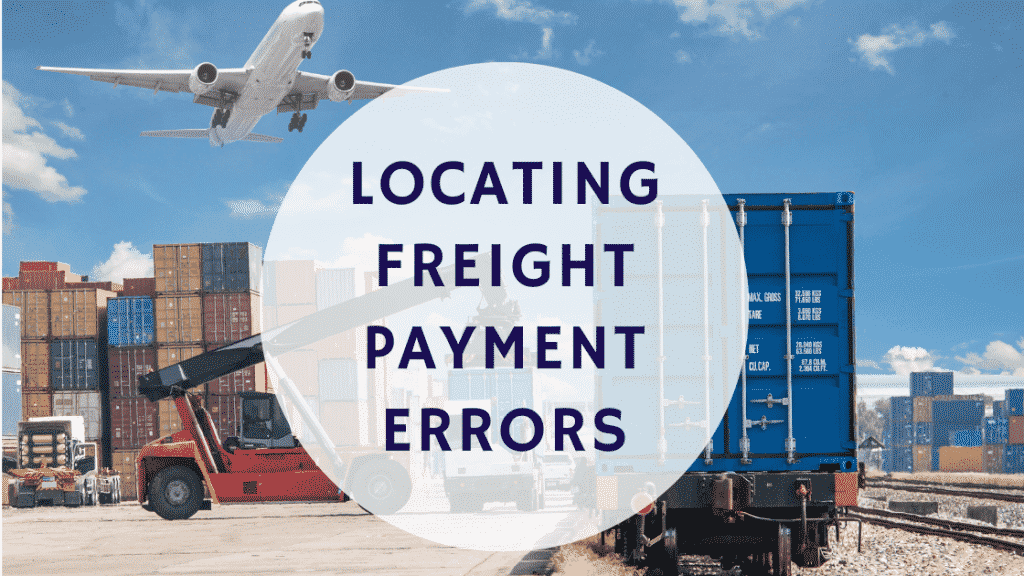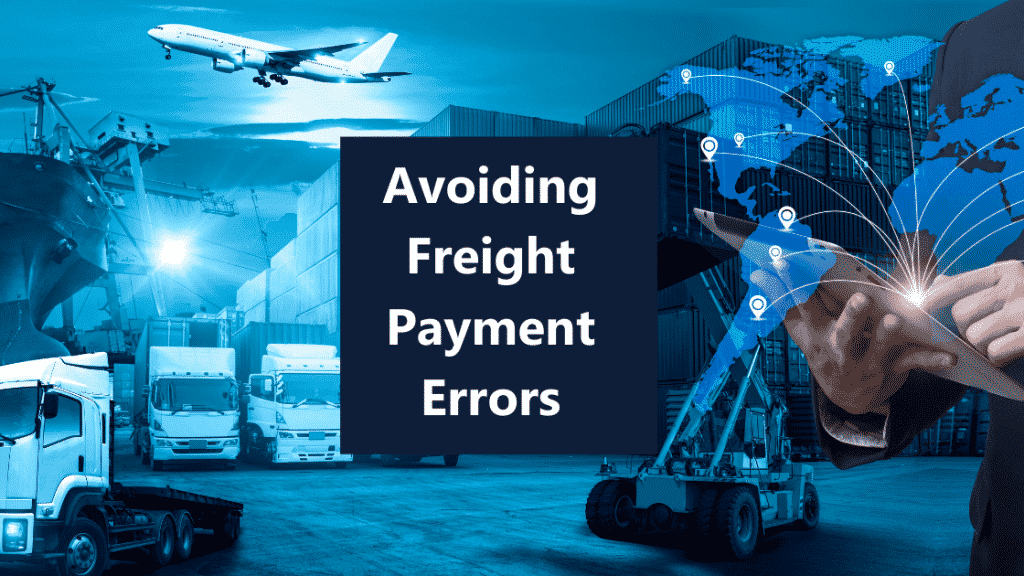Shipping Errors in freight payment to carriers are prevalent. If not identified, freight payment errors can result in thousands of dollars in overcharges or improper fees due to improper rates, mileage, duplicate bills, faulty classification, and data entry errors, among other issues.
Unfortunately, these are common blunders made by businesses. So, these questions beg to get answered: how can one detect errors, and, more importantly, how can one avoid them?
The Sources of Freight Shipping Mistakes & Errors
Freight claim errors can happen in a variety of ways.
Fortunately, the audit and reconciliation procedure gets triggered by a few recurring offenders. Thus, it is a good idea for organizations that are not currently on a digital platform or are shifting to one to work on the following typical concerns with freight bills:
Freight Billing Error #1 – Duplicate invoices cause a slew of data entry issues, not the least of which is charging for the same shipment twice or more.
Whether they are logged under identical purchase order numbers or are identifiable by their similar information, these problems are fairly easy to identify.
Base rate mismatches primarily cause systemic billing issues. If companies do not use the right base rate for calculating freight expenses, they will overcharge or undercharge their partners. As a consequence, cash flow liabilities may arise.
Freight Billing Error #2 – Incorrect freight classification contributes directly to invoicing mistakes.
This area is high-risk since there are 18 different types of freight, each with its own set of requirements for density, liability, storage, and other factors.
The application of taxes and tariffs, or the lack thereof, has an impact on invoicing amounts. An application is required to determine the proper tax rates for state, federal, and international shipping. Reconciliation issues arise when the wrong tax is applied or when duties are not applied.
Freight Billing Error #3 – Another major source of concern is discounting.
Though useful in attracting and retaining logistics partners, discounting can hurt everything from the base rate to the final total if it is not used and applied correctly.
Freight Billing Error #4 – Accessorials, like discounts and taxes, must be accounted for fully.
Shipping, handling, warehousing, last-mile delivery, and other processes necessitate accurate tally. Even simple data entry errors can cause the entire claim to get thrown off.
These are just a few of the dangers that companies might find on a single freight invoice. One or more of these problems necessitates a great deal of time and effort to fix, demonstrating the need for digital software that can avoid or resolve these problems in a relatively short time.
Locating Freight Payment Errors
Inconsistencies in freight invoices can easily go undetected. A decimal point can cause missed payments, overcharges, chargebacks, and many other complications in the wrong location, confusion over an invoice number, or even just the wrong date. Manual auditing, however, takes time and is still susceptible to the same human error that generated the errors in the first place. Thus, freight companies require a modern, digital solution to detect and reduce errors, streamlining the following process:
Step 1: Compare the invoice to the quote.
In business, a quotation is a document comparable to an invoice in that it provides similar information. However, it serves a distinct purpose: before the order is verified, it gives the customer a complete list of the product or service supplied.
Quotes are the initial point of contact with clients because they get issued before an invoice. Thus, it only fits that they are both balanced.
Step 2: Verify the shipment’s weight and dimensions.
When computing shipping and handling rates, freight companies might make mistakes that cost them money. For one, missing a UPS, FedEx, or USPS DIM (dimensional) or oversize rule for large or lightweight packages, is a significant shipping mistake.
Box shipment density, or the weight of the package in pounds per cubic foot, is referred to as “DIM.” The DIM restrictions can drastically increase the shipping expenses if the shipment is large enough or the weight is low enough.
Furthermore, UPS and FedEx have a specialized rule for oversized shipments, determined as length, or the longest side, plus girth (width x 2 + height x 2) amounting to more than 130 inches but less than a 165-inch maximum size restriction. A $45.00 premium gets imposed on the DIM or actual weight delivery fee for such big packages.
Step 3: Check the invoice against the negotiated discount.
When bargaining for a product, the seller may mention that the supplier comes directly from the manufacturer and offers a specific price — the factory invoice price. They may claim that they would not be able to go any lower. However, in most situations, dealers pay only a fraction of the official invoice amount in practical terms.
Contract and freight teams work hard to secure reasonable terms for organizations; thus, these terms must hold and remain in place. When checking their invoices and bridging all the dots between their contracts and bills, it is possible to avoid missing discounted rates between freight firms and third-party vendors by maintaining their agreements on file.
Here, vigilance is key: it is preferable to catch an accounting problem early on so that companies can immediately resolve the miscommunication between third parties, and a re-bill can be submitted to remedy the costs.
Avoiding Freight Payment Errors
Fortunately, freight payment errors can get avoided if not eliminated. With that, the following are the steps to prevent shipping mistakes on freight payments:
Step 1: Invest in software that searches for freight inconsistencies.
The manual auditing process gets slowed down by invoicing errors, no matter how little they are. Whatever the error, a freight auditor must track it back to its source, determine the correct information, and resubmit the invoice. From vendor relationships to cash flow, every aspect of a business would suffer if companies repeat this procedure several times a day.
The computer software that searches for freight disparities, on the other hand, will virtually always detect this type of inaccuracy. Audit technologies have been created within the freight and logistics industry to automate contract compliance monitoring. They want to do things like:
- Automate the detection of violations.
- Production of claims.
- Initiation of chargeback.
- Mitigation of risks to improve vendor relationships by auditing closer to the transaction.
- Accelerate cash flow through enhanced violation detection that identifies missed or undervalued claim opportunities that existing internal tools or outside authors overlook.
Choosing the Right Software
Because not all organizations audit invoices, in the same way, freight company owners should arrange for a demo and visit the company to confirm that they are a great fit for their needs.
Freight companies need not be shocked if not all freight settlement businesses work in the same way or have the same retention practices; instead, they must get prepared to ask questions. Moreover, companies must also consider how auditors will access their data and papers.
Finally, freight companies must consider the reporting capabilities of the software they lean towards purchasing. There is a lot more to freight payment data than just reports on carrier payments and cost allocation. Therefore it is ideal to ask queries that dig into:
- The ease with which programs can extract data in a format that is usable for analysis.
- The ability to compare exact freight lane data with those of other companies.
- The possibility to analyze supply chain execution and strategy validation using an optimizer provided by the freight audit and payment company.
Step 2: Establish a freight invoice auditing procedure.
Companies should include the process of assessing a freight bill and making any required revisions to verify its accuracy in a freight audit. This carrier invoice reconciliation checks the invoice to the agreed-upon terms, as well as the services delivered and received, to ensure that the quantities and conditions charged are correct and accurate.
Consider that manual audits take time, and it is easy to overlook mistakes as the task is tiresome and difficult to compare and remember. Moreover, a manual audit makes less sense as the number of shipping invoices grows. When using the manual method, it is more probable that batches of invoices will randomly get examined, leaving more room and potential for errors.
Finally, the quality of a manual audit is determined by the individual conducting it. It also comes with an opportunity cost because the person doing the audit may be preoccupied with other tasks, especially if it gets done in-house.
Step 3: Outsource freight payment and audit processes.
The time-consuming task of checking and confirming freight bills and cross-examining them with their corresponding shipments is known as a freight audit. After the statements have gotten validated and, if necessary, corrected, they get delivered to accounting for accounts payable, which is simply freight pay.
Outsourcing freight audit and payment (FAP) handles these two responsibilities to a qualified third party. All bills and shipping information get sent to a third party who checks and validates the bills before paying them using freight payment software.
When organizations outsource their FAP operations to a third party, they entrust the specialists to handle the time-consuming and costly issues that come with internal freight audits and payments, including:
- Dealing with a variety of carriers, each with its own set of procedures, fees, and details.
- Taking on an overwhelming quantity of FAP paperwork.
- Dedicating several precious internal resources to a work that will use a significant amount of their time.
- Timely resolution of errors, overcharges, and duplicate charges.
Instead of dealing with a slew of carriers and providers, a corporation can outsource FAP and have a single point of contact. Furthermore, when a firm grows, and freight auditing becomes more difficult, they would not have to spend money on new hiring, training, or other related costs.
With that, outsourcing helps to streamline processes while reducing internal paperwork and workload. Freight companies can then target their inner resources and, most crucially, hire seasoned consultants to help them maximize their FAP savings.
Future-Proofing
The recent COVID-19 pandemic surge has acted as a sobering reminder that future-proofing and contingency planning are essential for any company’s long-term survival. Because organizations’ expense gets minimized by outsourcing Freight Audit and Payment, they become more resilient and adaptive in the face of future crises. They can quickly adapt to shifting conditions because they have planned with their valued partners.
Conclusion
Among the best ways to avoid freight payment errors, Outsourcing is a standout. Freight Audit and Payment tasks are becoming increasingly important to outsource. When looking for an outsourcing partner, companies should look for someone who can meet their immediate needs and long-term objectives. In the end, businesses will profit from a partner who can help them understand, analyze, and make better decisions about their expenditure and overall strategy.




